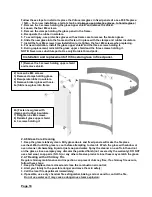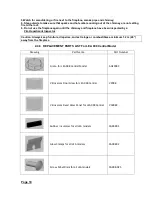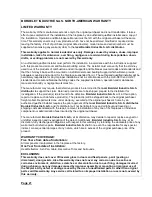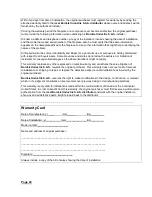
2.3.3 Building a Fire
To start a fire, unlatch and open the doors with the cool hand tool, making sure that the ashes have
cooled, clean-out surplus ash leaving a minimum 2.54cm (1’’) of ash to protect the grate. Open the
smoke-pipe damper with the damper cane, crumple some newspaper only on top of the grate then,
for quicker ignition, criss-cross several pieces of dry kindling in the firebox on top of the newspaper
and light the newspaper. Once the newspaper and the kindling are well ignited, close and latch the
doors with the cool hand tool and adjust the combustion air intake lever to its maximum position.
Wait until the kindling fire has turned into a good bed of embers and, prior to reloading, with cool
hand tool, unlatch and open the doors very slowly by 52 to 104 mm (2" to 4") for 10 seconds before
opening them completely. This will increase the draft and eliminate any smoke which is stagnant in
the fireplace. Make sure that the firewood is always on top of the grate. This will allow proper primary
air flow and prevent damage to the glass doors or fixed glass panels. Stack some dry firewood on top
of the embers and close and latch the doors with the cool hand tool. The unit will burn best with 2-3
pieces of firewood (Max. 9kg/20 lbs) spaced 1 to 2 inches apart to allow combustion air to get under
and around the fuel. Adjust the combustion air intake lever from its maximum position to the mid
position to vary the heat output.
2.3.4 Dangers of Creosote
When wood burns slowly or if it is not properly dry, it produces tar and other organic vapors which
combine with humidity to produce creosote. Creosote vapor condenses in the chimney left relatively
cool by the slow fire and coats the inside of the flue with a very flammable residue. When creosote
ignites, it produces a red-hot, extremely dangerous fire which can damage the whole installation and
even set fire to a home. At least once a week, it is recommended to make a brightly burning fire rather
than a lazy, smoldering fire. Not only will it keep the glass doors, glass panels, smoke pipe and
chimney cleaner but, what is most important, it will lessen the likelihood of chimney fires.
Caution: During the heating season, the chimney and smoke pipe need to be inspected at least twice
to determine if a creosote or soot has built-up above the safe limit of 3mm (1/8’’). If creosote or soot
accumulation exceeds 3mm (1/8’’) , immediately have the chimney and smoke pipe swept to lessen
the risk of a chimney fire.
2.3.5 Maintaining the Fire
Once the wood has been partially consumed and there is a good bed of embers, proceed to reload
the fireplace. Open the air control to its maximum for approximately 15 seconds prior to opening the
fireplace doors. Then, with cool hand tool unlatch and open the doors by 51 to 102 mm (2" to 4") for
10 seconds before opening them completely. This will increase the draft and thus eliminate the
smoke which is stagnant in the fireplace. Then reload the grate of the fireplace with fresh wood. The
Lea 998 fireplace will work best if a thick bed of hot embers is maintained in the bottom of the firebox,
and two large or three medium pieces of seasoned wood are added (Max.9kg/20 lbs). Combustion
efficiency is largely related to establishing a hot ember bed, and hot firebox temperatures. The
quicker the fireplace and chimney get up to normal operating temperatures, the better. A small
intense fire is preferable to a large smouldering fire, both to improve combustion efficiency and to
reduce the amount of creosote build-up. The best performance will be obtained by adding fuel to a
well-established ember bed, and then operating with the air inlet control open long enough to achieve
a hot fire. Use a poker to make an air channel in the embers below the wood to allow combustion air
to flow under the wood for a more efficient burn. Once the desired intensity of fire has been reached,
the combustion air control can be set to a medium setting, this will result in cleaner glass, less
creosoting, greater efficiency and a longer lasting fire.
2.3.6 Combustion Air
As is common with closed fireplaces, the combustion air control, located below the door, sets the
flow of air entering the firebox which allows for a more precise control of the fire. The quantity of
combustion air entering the firebox can be increased by moving the combustion air control from the
right (min.) fully to the left (max.). The combustion air control and smoke pipe damper should be in
the closed position when the fireplace is not in use to minimize air leakage up the chimney. In pre-
paration for using or cleaning out the fireplace and before opening the doors with the cool hand tool ,
open the combustion air control fully to minimize the possibility of a back draft coming from the
fireplace into the room and blowing ashes all over the floor.
Page 13
Summary of Contents for LEA 998 CFF
Page 7: ...Page 7...
Page 8: ...Page 8...








































